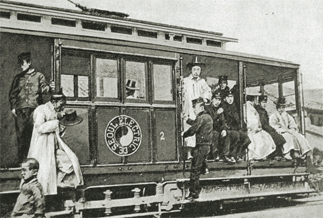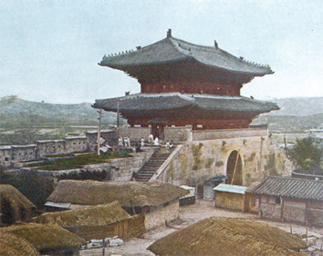Winds of change blow through the East Gate

Electric street cars in the city caused some accidents after they were introduced in 1899. Provided by Myongji University-LG Yeonam Library
In the photo (right), merchants wearing wide conical straw hats head for Dongdaemun, the capital’s great eastern gate. The ponies are pulling carriages loaded with faggots and freshly-cut wood.
Dogs lie on the street and thatched houses line the road.
Beyond the gate, properly known as Heunginjimun, awaits the bustling city where the weary travelers will sell their goods.
The wood will be used to build houses and bridges, and the faggots as firewood to heat people’s homes.
“Their journey possibly began as far away as Ttukseom near the Han River,” said Ahn Chang-mo, a professor of architectural history at Kyonggi University. Ttukseom in eastern Seoul was where merchants collected goods that had been ferried up the waterway.
This photo captures just another day in the early 1900s. It was produced as a stereoscopic image by U.S. stenographers Underwood and Underwood and used in several publications including “The Story of Korea” written in 1911 by British diplomat Joseph H. Longford (1849-1925), a consular official in Nagasaki, Japan, among others.

A road leading to Dongdaemun in the early 1900s reflects Korea’s modernization efforts with tram rails and industrial chimneys alongside old houses and carriages.
It’s safe to say the photo was taken some time between 1899 and 1911, considering the presence of the tram rails, installed in 1899, and the year Longford’s book was published.
Wind of change
The photo can be read as a symbol of Korea in transition, with the country quickly embracing the winds of change blowing from the West in the final years of the Joseon Dynasty (1392-1910).
To the left of Dongdaemun, two industrial chimneys belonging to a power plant jut out of the ancient, rustic landscape. The power plant stood where Dongdaemun General Shopping Center (Dongdaemun Jonghap Sangga) is today.

Thatched houses beside Dongdaemun inside the city walls in the early 1900s. By Myongji University-LG Yeonam Library
“Not only the construction of [an] electric tramway, the provision of long-distance telephones and telegraphs, the installation of electric light[s], a general renovation of its thoroughfares and its buildings, and the improvement of its system of drainage, does the capital of Korea give tokens of the spirit which is at work amongst its inhabitants,” he wrote.
Hamilton, who lived in Korea from the late 1800s to 1903, wrote extensively about the country. He took his own life on June 14, 1913, apparently due to financial difficulties.
Power surges
Hansung Electric Company constructed the Dongdaemun power plant from 1898 to 1900 in response to the growing demand for electricity.
The first electric light in Seoul had been in Gyeongbok Palace in 1887, then came the first electric street car in 1899 connecting Cheongnyangni in the east and Seodaemun in the west. The following year, the first public lamps were turned on along Jongno in central Seoul.

A view of Dongdaemun shopping town today. [JoongAng Ilbo]
The downside to the transition to electric power were the accidents. The area in front of the power plant was used as a garage for the electric street cars, according to Ahn of Kyonggi University, and unfamiliar with the street cars, many people got injured and some were even killed in accidents. According to records about the history of the Korean railroad, a street car killed a 5-year-old boy in May 1899, just days after the cars went into service.
The boy’s furious father and passersby set fire to the car and marched on the power plant, but company employees held them back.
But the popularity of the electric street cars grew as the years went by, with the number of passengers rising from 9,100 a day in 1910 to 150,000 in 1935, according to records.
One of a kind
Dongdaemun is one of a kind among the four great gates and four small gates of the capital. It is the only one with extra fortifications built outside the gate.
“Dongdaemun is built on lower ground than the other gates so [the authorities] built another fortified wall outside for added defense,” noted Yun Dae-gil, the director of Josun Architects Office. Yun is keen on the restoration of historic architecture.
The Annals of the Joseon Dynasty show that Joseon officials thought the extra fortification would protect the entrance and beef up security.
The texts also state that King Taejo (1335-1408), the founding king of Joseon, visited the site of the construction of the outer fortress himself.
Korea’s Treasure No. 1, Dongdaemun was built in 1396. The gate has undergone a number of repairs and renovations. The Dongdaemun we see today was almost completely rebuilt in 1869.
While all eight gates are imbued with distinct characteristics and anecdotes, there was one very intriguing belief about Dongdaemun: That the gate would tilt whenever there was a national tragedy looming.
According to the Annals of the Joseon Dynasty, Dongdaemun tilted before the execution of King Danjong (1441-1457), a coup by Gwanghaegun, or Prince Gwanghae, (1574-1641) and a military revolt in 1882.
By Kim Hyung-eun [hkim@joongang.co.kr]
*The photos are provided by Myongji University-LG Yeonam Library, where the relevant books are stored. Ahn Chang-mo, a professor at Kyonggi University, Park Ju-seok, a professor at Myongji University, Kim Jang-choon, a professor at Myongji College, and Kim Jong-hun, a professor at Paichai University, acted as consultants for this series.
Constant change for a modern city
When workers began to tear down Dongdaemun Stadium in September last year, little did they know what treasures awaited them beneath the soil.
In line with its repeated emphasis on city design, the Seoul city government announced in October 2006 it would tear down near-defunct Dongdaemun Stadium and build design facilities.
The architect Zaha Hadid was invited to plan Dongdaemun Design Plaza and Park, which will be built on the former site of the stadium in north-central Seoul.
However, workmen uncovered important cultural relics during the initial stages of the dig. Archeologists at Jungwon Cultural Properties Institute said the finds include parts of the city wall; Igansumun, a gate which controlled the water flow from Mount Namsan to Cheonggye Stream; and the former site of a Joseon Dynasty (1392-1910) military training facility.
In response, Seoul city government has announced it will change the plans for the new design park to accommodate the area’s history.
According to the new plan, the city wall will be restored, and the city government will work with the Cultural Heritage Administration to find ways to touch up other historic properties.
Skeptics doubt that much harmony will be found between Dongdaemun Design Plaza and Park and what the historic finds will create, but supporters anticipate some sort of synergy.
Seoul Mayor Oh Se-hoon said at a ground-breaking ceremony for the park last month he expects “an organic storytelling from the juxtaposition of the ultramodern building and the relics from 600 years ago.”
Cheon Eui-yeong, a professor of architecture of Kyonggi University, says it’s only natural that people feel some resistance to change. “Building a new structure itself is in a way a destructive act,” he says. “But that’s what a metropolis is about: constant clashes, contradictions and conflicts.
“How did the people of Seoul feel when the authorities set up the walls and gates 600 years ago?”
Dongdaemun Design Plaza and Park is expected to be completed in 2011.
Old Seoul: frame by frame series










with the Korea JoongAng Daily
To write comments, please log in to one of the accounts.
Standards Board Policy (0/250자)